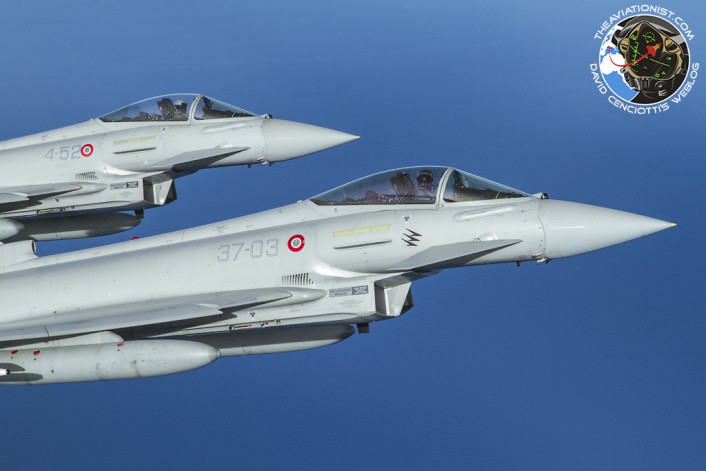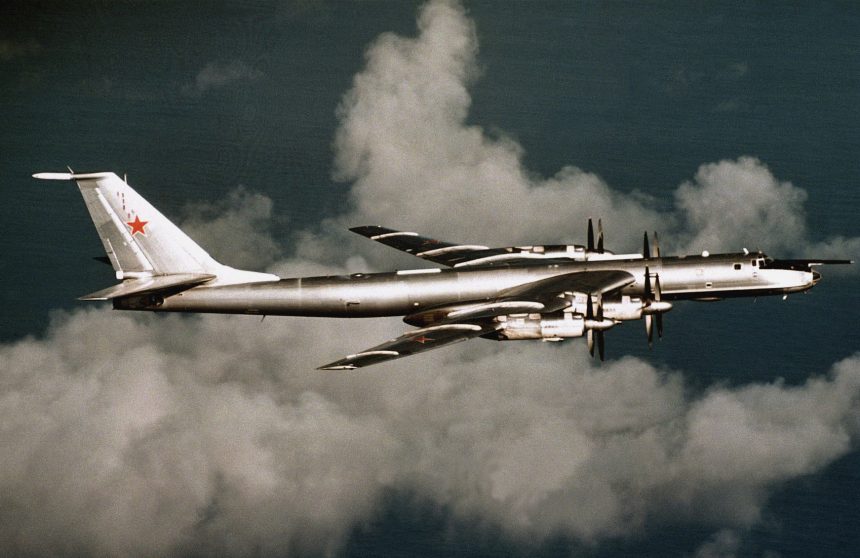Two Russian Navy Tu-142 Bear-F long-range maritime patrol reconnaissance and anti-submarine warfare aircraft were intercepted by the Italian Eurofighter Typhoon aircraft.
On Mar. 18, 2019, the Italian Air Force Typhoons deployed to Iceland to support NATO’s Air Policing operations, were launched to carry out a VID (Visual IDentification) of two Russian Tu-142 aircraft flying in international airspace in the vicinity of Icelandic borders.
The intercept was the first carried out since the Italian Eurofighter Typhoons deployed to Keflavik, Iceland, on Mar. 11, 2019, to undertake QRA (Quick Reaction Alert) duties, providing intercept capabilities for Iceland, a NATO ally that does not have a full range of air defence assets.

This is the fourth time, after 2013, 2017 and 2018, the Italians deploy to Keflavik for NATO’s Icelandic Air Policing; a task that, over the past decade, has been carried out also by fighter aircraft from Canada, the Czech Republic, Denmark, France, Germany, Italy, Norway, Portugal and the United States.
During the 4-week deployment, along with the standard air policing activities, the Italian Typhoons, will also conduct joint training activities together with the Icelandic Coast Guard and the NATO Control and Reporting Centre.
While a VID on a Russian aircraft flying in international airspace has become a standard practice for both Italian and NATO aircraft supporting enhanced air policing at the borders of NATO’s airspace in the “High North”, what makes this mission particularly interesting is the fact that the close encounter involved two Tu-142s.
Unfortunately, no image of the intercept was released by NATO, however, the Tu-142 must have been one of the two variants rarely spotted (mainly in the Baltic area) in the last couple of years: the Tu-142MK or the newer Tu-142MZ (the variant that can be distinguished by the presence of the chin fairings), the last production variant of the “Bear F”, with new NK-12MP engines and a new avionics suite, a variant dubbed Bear-F Mod. 4.
This is what we wrote about this aircraft when an MZ made a “surprise visit” to the USS Mount Whitney, during Ex. Trident Juncture off the Norwegian coast.
According to “Russia’s Warplanes, Volume 2” by Piotr Butowski published by Harpia Publishing, one of the most authoritative sources on Russian-made military aircraft and helicopters today, the Russia’s Naval Aviation has two Tu-142 squadrons, one with Tu-142MK (NATO reporting name Bear-F Mod. 3) aircraft at Kipelovo-Fedotovo and one with Tu-142MZ (Bear-F Mod. 4) at Mongoktho.
The Tu-142MK and MZ are both able to carry a maximum of 9,000 kg (19,842lb) weapons load inside two fuselage weapons bays, with options including three torpedoes (the rocket-propelled APR-2/APR-3, or the electric AT-2M or UMGT-1) or depth charges (such as the Zagon/Zagon-2 guided charges and nuclear depth charges), mines and sonobuoys. The typical loadout of a Tu-142MK comprises 3x torpedoes and 66x RGB-75, 44x RGB-15, 10x RGB-25 and 15 RGB-55 sonobuoys.
Moreover, it’s worth of note that these MPA (Maritime Patrol) and ASW (Anti-Sub Warfare) aircraft rarely operate in pairs. Were they involved in a long-range exercise, a ferry flight or just a “show of force” in response to the B-52 flights in the Baltic area?
The Italian Typhoons have contributed to the enhanced air policing across all Europe, including Bulgaria, Montenegro and the Baltic States. From January to April 2018, when four Italian F-2000 Typhoons were deployed to Amari, Estonia, as part of the Enhanced Air Policing North Baltic Eagle, the Italian Air Force was securing the airspaces of six nations [Italy, Estonia, Lithuania, Latvia, Slovenia and Albania (on a rotational basis with effort shared with the Hellenic Air Force)]. A record within NATO.









